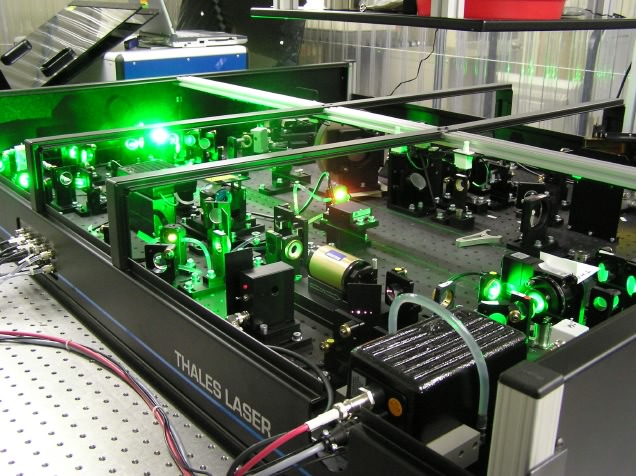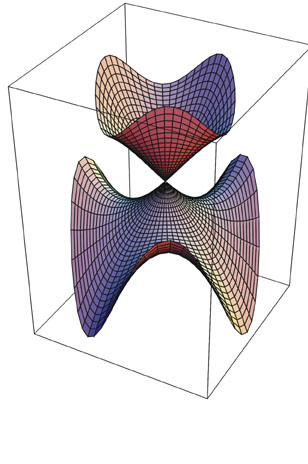1. Current Research and Principal Research Interests

|
(1) Interaction
between an Intense Ultrafast Laser and Molecule. New research fields
opened related to the interaction between molecules and high-intensity optical
fields, where the laser intensity ranges from 1012 ∼ 1017
Wcm-2. Ionization is the most fundamental process that such an
intense femtosecond laser induces. A large set of experiments and theoretical
considerations have been reported in the cases of atoms and few-atomic molecules.
In the study of molecular ionization, the origin of fragmentation is one of
the central topics today. The fragmentation of ions can occur for molecules
but not for atoms. Most large molecules show heavy fragmentation with 0.8
μm pulses even at a low-intensity regime (1013 Wcm-2).
This makes the analysis of experimental results highly complicated and prevents
us from comparing the results against theoretical predictions. An intact molecular
ion formation is desirable not only for analytical application but also for
fundamental studies. Recently, the importance of radical cation in the post-ionization
process has increasingly recognized, and the arguments about fragmentation
mechanism is still continuing. To avoid fragmentation, we can use shorter
duration pulse and/or pulses at a suitable wavelength, which is off-resonant
with the molecular cation radicals. Generally, a longer wavelength is better
than a shorter one. The clear presentations of experimental results were
reported using longer wavelength pulses. These findings are quite useful
for analytical purposes. We have shown the ability of femtosecond laser ionization
method for dioxin detection.
In an intensity region higher than 1016 Wcm-2, electrons
are stripped from molecules by optical field ionization and the highly charged
ions reach a Coulomb explosion. Coulomb explosions of benzene and C60
have been demonstrated and the mechanism can be analyzed by molecular dynamic
simulation. The intact ion formation can be used for femtosecond laser mass
spectrometry.

|
(2) Ultrafast chemical
reaction dynamics probed by time-resolved dissociative ionization.
We have been interested in dynamics of nonradiative processes such as internal
conversion, solvent relaxation, and chemical reactions. Our aim is to study
not only basic phenomena of nonradiative processes (the dynamics of intramolecular
charge-transfer excited state: enhanced internal conversion induced by hydrogen
bonding interaction) but also the reactions of highly vibrationally excited
state formed after an internal conversion. It is concluded that an internal
conversion is not a useless photophysical process (many people have thought
it as an only energy dissipation process) but a very interesting process that
forms an important intermediate in multiphoton hot molecule chemistry. Transient
emission and absorption spectroscopy was used in the course of these studies
to investigate the photophysical processes and photochemical reactions; however,
the application of these techniques are limited to some extent. New transient
spectroscopy that can measure the dark (non-emissive) state is strongly needed
for more understanding about the nonradiative processes and photochemical
reactions.
The member of Max-Planck-Institut für Qunatenoptik
(Germany) has developed a technique to monitor the path of the molecule all
the way along the potential energy surfaces from the primary excited state
(Franck-Condon region) down to the ground state of the products or reactant.
There are no dark states in this method because nonresonant multiphoton ionization
with mass selective detection of the ion yields was used. A crucial feature
is that many (ion) signals are observed, and the success is based on the fact
that the fragmentation pattern is different for different locations on the
potential energy surfaces. We are also studying the nonresonant ionization
process with a high intense femtosecond laser (operated with the laser power
between 1013 ∼ 1016 Wcm-2) in collaboration
with physicists of Osaka university. Our aims are: (1) detection of a small
amount of molecule, which is difficult to be detected by other techniques
such as laser induced fluorescence (e.g. chlorinated compound such as dioxin);
(2) investigation and application of highly energized and charged atoms formed
by Coulomb explosion (X-ray generation etc.). On the other hand, the scientists
of Max-Planck-Institut aimed to investigate the reaction dynamics. Although
we and the members of Max-Planck-Institut made different approaches, both
found similar and important features in such an ionization process. Phenomenologically
it was clear that femtosecond intense laser pulses lead to enhanced formation
of parent ions compared with nanosecond laser excitation. However, heavy fragmentation
was observed in some molecules. We generalize that the non-resonance between
the laser wavelength and the electronic energy levels of parent cation is
a key factor in the formation of the parent ion during femtosecond laser excitation.
We started the joint-project on both, methodological
development and its application to several interesting problems of ultrafast
chemical reaction dynamics through conical intersection (intramolecular charge
transfer excited state, highly vibrationally excited state etc.) based on
the findings described above. (collaboration with Dr. Fuß, Dr. Schmid,
and Dr. Trushin in Max-Planck-Institut für Quantenoptik, Germany)
(3) Chemical reactions of vibrationally excited molecules:
single- and multiphoton reactions of hot molecules. The highly vibrationally
excited state, namely a hot molecule, which has an equivalent vibrational
temperature of 2000-4000 K, would be produced after a rapid internal conversion
from an electronically excited state. We are studying the hot molecule chemistry
of large molecules. In these cases, product formations by the two- or more
photon process were observed. A single photon absorption would not be sufficient
to induce a chemical reaction of such large molecules, which have many vibrational
modes. It would be necessary to accumulate energy by a successive second
photon absorption to overcome the activation energy of the chemical reactions
as well as to fulfill the reaction rates higher than the collisional relaxation
rates. In these cases, it would be reasonable to conclude that the hot molecules,
which were created by the first photon, effectively absorbed the second photon
because the hot molecules have a strong absorption at the laser wavelength
as same as the parent molecules. The new reaction pathway would be expected
for many molecules even though they hardly react by photolysis (single photon
absorption), if hot molecules absorbed the second photon. The equivalent
vibrational temperature with an internal energy of two photons is high enough
to induce the reactions in the electronically ground state. The most important
difference from the thermal reactions at the same temperature is that the
products can be cooled down by collisional relaxation for the case of hot
molecule. Therefore, different products would be expected. We have found
several examples of new reaction pathways in photo-inert molecules. The multiphoton
hot molecule chemistry could be the way to develop a new area of photochemical
reactions.
(4) Anisotropic radiationless deactivation process induced
by hydrogen-bonding interaction. Aminoanthraquinones (AAQ) and aminofluorenones
are characteristic molecules that exhibit strong intermolecular hydrogen-bonding
interaction in the excited state, since the excited states have a strong
intramolecular charge-transfer nature. The large electron density on the
carbonyl oxygen of AAQ in the excited state strongly promotes an intermolecular
hydrogen-bonding interaction with nonconjugated molecule such as an alcohol.
An intermolecular hydrogen-bonding with the hydroxyl group of alcohol was
revealed to be a dominant mode of radiationless deactivation to the ground
state, and the electronic excited energy was supposed to dissipate through
the hydrogen bond as vibrational energy. Recently, we have found that not
only alcohol but also hydroperoxide quenched the fluorescence of AAQ. With
the fluorescence-quenching the decomposition of hydroperoxide was observed.
The decomposition of hydroperoxide could mean that dissipated energy through
the intermolecular hydrogen bond was converted selectively to induce chemical
reaction such as bond cleavage. Stern-Volmer analyses for the obtained products
show that the decomposition was closely related to fluorescence-quenching
process. From the viewpoints of energy dissipation, upon radiationless deactivation
from the electronically excited state the excited energy has generally been
accepted to dissipate randomly through the surrounding solvent molecules.
The sensitized decomposition of hydroperoxide coupled with radiationless deactivation
strongly suggests that the excited energy is not randomly but at least partly
selectively transferred to a specific molecule surrounding the chromophore
in the case. An investigation of the microscopic molecular mechanism of radiationless
deactivation by intermolecular hydrogen-bonding interactions would clarify
the problem of whether the energy dissipation is inherently isotropic or
anisotropic. (collaboration with Prof. Haruo Inoue in Tokyo Metropolitan
University)
2. Selected Publications
1) Molecular Mechanism of Radiationless Deactivation of Aminoanthraquinones through Intermolecular Hydrogen–Bonding Interaction with Alcohols and Hydroperoxides
Yatsuhashi, T.; Inoue, H.*, J. Phys. Chem. A 1997, 101 (44), 8166-8173.
2) A Hot Molecule as an Intermediate in Multiphoton Reaction: First Photoinduced Reaction of Biphenylene
Yatsuhashi, T.;* Akiho, T.; Nakashima, N.*, J. Am. Chem. Soc. 2001, 123 (41), 10137-10138.
3) Ultrafast Charge Transfer and Coherent Oscillations in 4-Piperidino-benzonitrile
Yatsuhashi, T.; Trushin, S. A.; Fuß,* W.; Rettig, W.; Schmid, W. E.; Zilberge, S., Chem. Phys. 2004, 296 (1), 1-12.
4) Femtosecond Laser Ionization of Organic Amines with Very Low Ionization Potentials: Relatively Small Suppressed Ionization Features
Yatsuhashi, T.;* Obayashi, T.; Tanaka, M.; Murakami, M.; Nakashima, N., J. Phys. Chem. A 2006, 110 (25), 7763-7771.
5) Anisotropic Bulletlike Emission of Terminal Ethynyl Fragment Ions: Ionization of Ethynylbenzene-d under Intense Femtosecond Laser Fields
Yatsuhashi, T.;* Murakami, M.; Nakashima, N., J. Chem. Phys. 2007, 126 (19), 194316 (10 pages).
6) High-Order Multiphoton Fluorescence of Organic Molecules in Solution by Intense Femtosecond Laser Pulses
Yatsuhashi, T.;* Ichikawa, S.; Shigematsu, Y.; Nakashima, N., J. Am. Chem. Soc. 2008, 130 (46), 15264-15265.
7) Ionization of Anthracene Followed by Fusion in the Solid Phase under Intense Nonresonant Femtosecond Laser Fields
Yatsuhashi, T.; Nakashima, N.*, J. Phys. Chem. C 2009, 113 (27), 11458-11463.
8) Formation and Fragmentation of Quadruply Charged Molecular Ions by Intense Femtosecond Laser Pulses
Yatsuhashi, T.;* Nakashima, N., J. Phys. Chem. A 2010, 114 (28), 7445-7452.
9) VUV Laser Chemistry - Formation of Hot Molecules and Their Reactions in the Gas Phase –
Yatsuhashi, T.;* Nakashima, N., Bull. Chem. Soc. Jpn. 2001, 74 (4), 579-593.
|